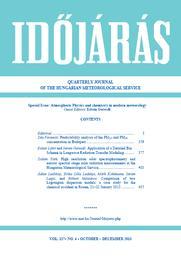IDŐJÁRÁS - angol nyelvű folyóirat
Vol. 117, No. 4 * Pages 359–450 * October - December 2013
 |
Special Issue: Atmospheric Physics and chemistry in modern meteorology Guest editor: István Geresdi |
Predictability analysis of the PM2.5 and PM10 concentration in Budapest
Zita Ferenczi
idojaras.2013.4.1 (p. 359–)
Zita Ferenczi
idojaras.2013.4.1 (p. 359–)
Application of a detailed bin scheme in longwave radiation transfer modeling
Eszter Lábó and István Geresdi
idojaras.2013.4.2 (p. 377–)
Eszter Lábó and István Geresdi
idojaras.2013.4.2 (p. 377–)
High resolution solar spectrophotometry and narrow spectral range solar radiation measurements at the Hungarian Meteorological Service
Zoltán Tóth
idojaras.2013.4.3 (p. 403–)
Zoltán Tóth
idojaras.2013.4.3 (p. 403–)
Comparison of two Lagrangian dispersion models: a case study for the chemical accident in Rouen, January 21-22, 2013
Ádám Leelőssy, Erika Lilla Ludányi, Márk Kohlmann, István Lagzi, and Róbert Mészáros
idojaras.2013.4.4 (p. 435–)
Ádám Leelőssy, Erika Lilla Ludányi, Márk Kohlmann, István Lagzi, and Róbert Mészáros
idojaras.2013.4.4 (p. 435–)
IDŐJÁRÁS folyóirat

Az IDŐJÁRÁS a HungaroMet Nonprofit Zrt. negyedévenként megjelenő angol nyelvű folyóirata
Megrendelhető a journal.idojaras@met.hu címen.
A szerzőknek szánt útmutató itt olvasható.
Megrendelhető a journal.idojaras@met.hu címen.
A szerzőknek szánt útmutató itt olvasható.









